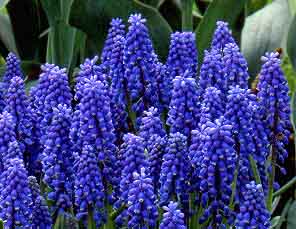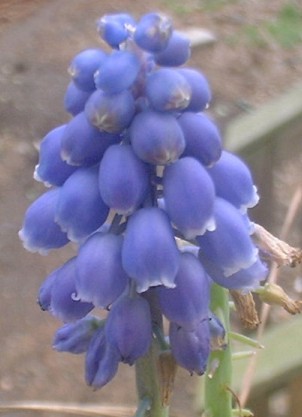|
Gardens Ablaze |
||
|
|
Grape
Hyacinth
|
|
|
Detailed Bulb Profiles Site Map
Home
|
Grape Hyacinths do well from zone 3 to zone 9, so they are a viable option for most of us. They are also one of the plants to choose if deer are a problem in your area. Planted at the bases of shrubs, or left to naturalize under trees, they can have a stunning effect. They make good companions to Daffodils, Tulips, alyssum, candytuft, and just about any other spring plant you can think of, adding a beautiful shade of blue that is otherwise hard to come by at that time of year. They will tolerate most soils, except areas that don't drain well. They have grass-like, gracefully arching leaves, and make good border and container plants. They will do well in full sun to part shade.
In my own garden, I was fortunate enough to already have some Grape Hyacinths growing when I moved in. They were in the middle of the lawn, so I moved some of them to a rocky area that gets little sun and has rather poor soil. They have done extremely well under these circumstances, completely covering the area within just a few years, with basically no interference from me. I also put a few in a container with some other bulbs years ago. That container is now completely filled with the Grape Hyacinths. It is a beautiful sight when it blooms in the spring, and I get a lot of comments on that particular container planting. Once the spring is over, I put the container in a shady place and forget about it until once again in the fall the leaves emerge. All in all, this is probably the easiest container and naturalizing plant I have ever found, so if you haven't tried Grape Hyacinths, don't discount them because of their small size. Try some this year - and you will be rewarded for a lifetime.
Custom Search
|
|
|
Gardens Ablaze |
||
 Grape
Hyacinth, otherwise known as Muscari, are actually not Hyacinths at all.
They are members of the Lily family, and are native to the Mediterranean area
and Asia Minor. They are small plants, usually not much more than 10
inches tall, and produce blue or purple petals that are fused together and have
small white tips, giving them a balloon-like or, well.....grape like appearance,
and they have sort of a musky-grassy smell. One grape
hyacinth plant doesn't look like much, but in a mass planting, these small bulbs
can be a total knockout.
Grape
Hyacinth, otherwise known as Muscari, are actually not Hyacinths at all.
They are members of the Lily family, and are native to the Mediterranean area
and Asia Minor. They are small plants, usually not much more than 10
inches tall, and produce blue or purple petals that are fused together and have
small white tips, giving them a balloon-like or, well.....grape like appearance,
and they have sort of a musky-grassy smell. One grape
hyacinth plant doesn't look like much, but in a mass planting, these small bulbs
can be a total knockout.  Grape Hyacinths come to
life just as everything else is dying down. Bulbs should be planted in the
fall. In established plantings, the leaves will emerge in late summer and
persist through the winter, making a nice looking winter border along paths,
etc. They will tolerate very cold weather, down to at least zero, but may
experience some damage in extreme weather. They flower in early to
mid-spring, and after flowering, as with most bulbs, the leaves should be left
intact until they die back. They are propagated by seed or by
separating their bulb offsets, which is the more common way.
Grape Hyacinths come to
life just as everything else is dying down. Bulbs should be planted in the
fall. In established plantings, the leaves will emerge in late summer and
persist through the winter, making a nice looking winter border along paths,
etc. They will tolerate very cold weather, down to at least zero, but may
experience some damage in extreme weather. They flower in early to
mid-spring, and after flowering, as with most bulbs, the leaves should be left
intact until they die back. They are propagated by seed or by
separating their bulb offsets, which is the more common way.